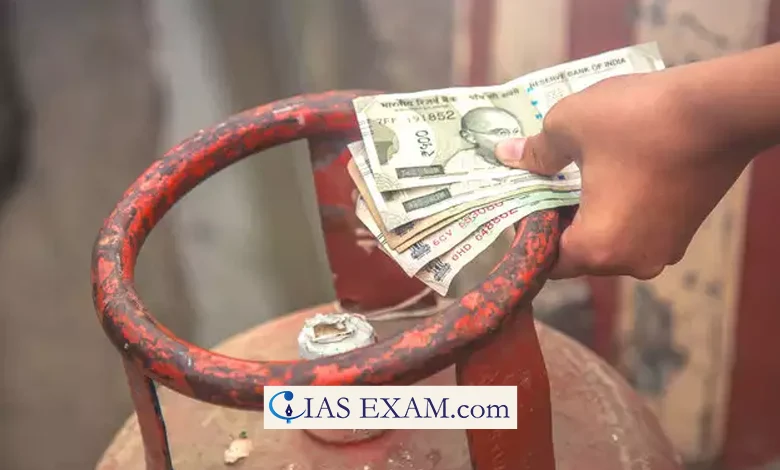LPG Price hikes affect Society and the Environment
Syllabus: Environment and Pollution [GS Paper-3], Social Issues[GS Paper-2]

Context
The 2014-2015 ACCESS survey conducted by the Council on Energy, Environment and Water revealed that the main obstacle preventing rural poor households from adopting and using LPG is its high cost. As a result, approximately 750 million Indians rely on solid cooking fuels such as wood, dung, agricultural residues, coal, and charcoal, despite the numerous health, socio-economic, and environmental risks associated with them.
Environmental Impacts
The increase in LPG prices has led to a surge in the use of alternative fuels such as firewood and kerosene, resulting in:
- Increased Air Pollution: During the combustion process, the smoke produced by the burning of wooden and kerosene products includes toxin compounds such as particulate formation, carbon monoxide, and volatile organic compounds giving rise to air pollution.
- Deforestation and Habitat Destruction: Besides, the forest was the main victim of illegal deforestation, because of the population’s firewood demand, which has in turn contributed to deforestation, loss of biodiversity, and disruption of the ecosystem.
- Climate Change: People are switching to kerosene and other fossil fuels as their preferred energy source at a very high rate. The use of these fuels, thus, ends up emitting large amounts of greenhouse gases into the atmosphere. These gases are a major contributing factor to the warming of the earth’s atmosphere.
Social Impacts
The LPG price hike has significant social implications, particularly for low-income households, including:
- Increased Energy Expenditure: The rise in the price has contributed to augmenting energy expenditure of the low-income families. This led them to channel a larger portion of their income towards the payment of energy bills.
- Reduced Access to Clean Cooking Fuel: The rise of LPG price has not only affected the people within low income households but also forced them to resort to cheap and pollution emitting fuels such as firewood and kerosene.
- Negative Impact on Health and Wellbeing: If the yellow-numbered fuel, which causes a nauseous smell when it is combusted by the vehicle engines, continues to be pumped, the people in the area will be exposed to health issues such as breathing problems and eye and skin problems.
Economic Impacts
The LPG price hike has significant economic implications, including:
- Increased Cost of Living: The increase of prices has been experienced not only by families but by all individuals across the board, this is bad news as it forces individuals to reduce the number of goods that they need for survival due to increase in cost of living.
- Reduced Purchasing Power: The hike of LPG prices means the low-income households lose their buying power, thus, they have to slash their costs that results in reducing their expenditure.
- Impact on Small-Scale Industries and Businesses: The rise of LPG price caused small businesses and stores, which used to collectively use it in big quantities, to realise the hard consequences of this price increase. Consequently, those businesses caused the costs to rise and their profit to lower down.
Government Initiatives
- Subsidy Schemes for Low-Income Households: As far as decision making is concerned, the government is clear from the beginning that it again has subvention promise, and these agendas mainly target the poor by allowing them to buy LPG gas at a subsidised rate.
- Promotion of Alternative Clean Energy Sources: The government is propagating through policy development new alternative energy sources to households and businesses such as biological and solar with subsidies and involvements for the uptake of green fuels.
- Increased Funding for Renewable Energy Projects: The government has increased its budgets. Apart from renewable energy projects, the main objects have been to curb the increase of fugitive fuels and establish sustainable sources of energy.
Way Forward
To address the socio-ecological effects of LPG price hikes, it is essential to:
- Promote Sustainable Energy Sources: The government and its citizens have to form a broad unity to support the adoption of sustainable energy alternatives such as solar power, wind turbines and biogas and also try to cut down this reliance on exhaustive fossil fuels.
- Increase Energy Efficiency: If we manage to do so, it will be they who are going to achieve more efficient and more responsible use of energy resources and also save money.
- Support Low-Income Households: Government should continue offering targeted subsidies and programs granted to poor families for the subsidy to or given the favour to fuel access that is based on the income status of the people.
Conclusion
The socio-ecological effects of LPG price hikes are far-reaching, affecting not only the environment but also the social fabric of our society. It is essential to address these impacts through a combination of government initiatives, sustainable energy sources, and increased energy efficiency. By working together, we can create a more sustainable and equitable energy future for all.
Source: The Hindu
UPSC Mains Practice Question
Q. Discuss the socio-economic and environmental implications of LPG price hikes on both urban and rural communities in India. How can government policies mitigate the adverse effects of such hikes while promoting sustainable energy usage?





.png)



